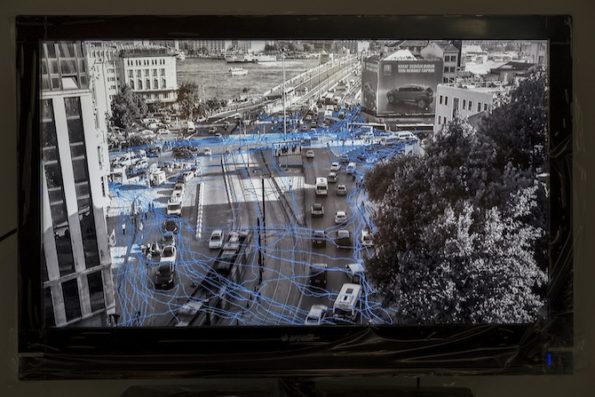Search
To search for an exact match, type the word or phrase you want in quotation marks.
A*DESK has been offering since 2002 contents about criticism and contemporary art. A*DESK has become consolidated thanks to all those who have believed in the project, all those who have followed us, debating, participating and collaborating. Many people have collaborated with A*DESK, and continue to do so. Their efforts, knowledge and belief in the project are what make it grow internationally. At A*DESK we have also generated work for over one hundred professionals in culture, from small collaborations with reviews and classes, to more prolonged and intense collaborations.
At A*DESK we believe in the need for free and universal access to culture and knowledge. We want to carry on being independent, remaining open to more ideas and opinions. If you believe in A*DESK, we need your backing to be able to continue. You can now participate in the project by supporting it. You can choose how much you want to contribute to the project.
You can decide how much you want to bring to the project.

Is a Museum a Battlefield? is the title of the work that Hito Steyerl is presenting in the 13th Istanbul Biennial. A particularly pertinent title given the circumstances under which this year’s Biennial has been organised. The night before the opening to the public there were renewed confrontations in the streets of the city, this time on the Asian side of the Bosphorus; walking through the streets of Kadiköy inhaling tear gas became inevitable.
The conceptual framework of the 13th Istanbul Biennial focuses on the confluence in the public space of the urban, social, political, ecological and economic transformations and problems, that in the last years have affected the city and its inhabitants; an unavoidable subject in the work of many artists, be they local or from abroad. Concepts like gentrification, agoraphobia, peripheral or site-specific, resound. The Basque artist Maider López has arranged some cameras that transmit in streaming the coexistence of traffic and pedestrians in Karaköy, a particularly complicated point of the city. On the screen the apparently random pathways of those who are trying to cross the streets are described. It is accompanied by an “instruction manual”, in which the second point says, “when a system doesn’t fit, create new ways”, -which could also be a good title for this text-.
The geographical location of Istanbul, as the portal between Europe and Asia, has historically given it a privileged role, conferring a unique situation on the city, halfway between sustained traditions and constant change. Hence why reflections on the public and urban space of Istanbul are nothing new: previous editions of the biennial had already focussed, from different points of view, on this analysis. But on this occasion focussing on the public space entails different implications. Initially the plan had been to occupy public spaces, but with the confrontations in Gezi Park and Taksim Square in May, the team had to reconsider the form of this exhibition. The streets were already battlefields, full of smoke, but also of art actions. The contradiction of acting in accord with the premises of a government that extended its hands to silence the protests in the streets became evident. Finally the curatorial team decided not to intervene directly in the public space and to confine their particular battle to within the impeccable, white walls.
The work of Hito Steyerl cited at the beginning of this text unveils an investigation into, and a series of reflections on, the relation of some of the sponsors, that are armament manufacturers, with the Biennial, inviting us to reflect on which types of weapons are used in each battlefield.
The fact that in the end the biennial takes place in five exhibition spaces limits its possibilities, resulting in a sort of catalogue of engagés artists. Artists and intellectuals have also been victims in the Taksim confrontations and the defence of freedom of expression and culture in contemporary Turkey is a central theme in this exhibition. “Suspect” by Guillaue Bijl is the recreation of an artist’s studio after it has been searched by the police. Carla Filipe exhibits some old books in which time has drawn the pretty pathways made by book-eating insects, the precious forms on the paper are, according to the artist, the representation of culture being swallowed up by nature.
I understand that the question Hito Steyerl proposes is interesting, but when I head to her lecture taking place in one of the galleries, I can barely enter the room and decide to leave. Before, however, I pick up a transcription of her talk and discover that there is only the version in Kurdish. I ask for the English version but apparently it doesn’t exist. Still today the Kurdish conflict is one of the gravest conflicts in the country, the Kurdish language isn’t officially recognised in the Turkish state and it has been prohibited on many occasions.
What battle is being fought within the museum? The title of the biennial “Mum, am I a Barbarian?” refers to minorities, to those excluded from society, the marginalised, those who talk foreign languages, those who aren’t good citizens… This year, for the first time, entrance is free for everybody. Is the museum a space for all of them?

Caterina Almirall has only just been born into this world, but has lived in others, in similar parallel worlds, both liquid and solid. From each she has learnt something, and forgotten something else. Learning to unlearn. In all of these worlds she has been caught up in a web that interweaves everything, some call it ’art’…Entwining, unravelling, weaving and destroying this labyrinth has been her occupation in each one of these planets, and she fears that it will be the same in each of the ones to come.
"A desk is a dangerous place from which to watch the world" (John Le Carré)